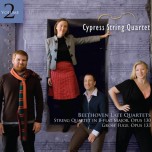How She Danced: String Quartets of Elena Ruehr
String Quartet #4 (2005) Commissioned by the Cypress String Quartet
String Quartet #3 (2001) Commissioned by the Rockport C.M.S.
String Quartet #1 (1991) Winner, ASCAP Award
The Cypress String Quartet released How She Danced: String Quartets of Elena Ruehr on Tuesday, February 23, 2010. The album includes acclaimed Boston-based composer Elena Ruehr's String Quartets No. 1 (1991), No. 3 (2001), and No. 4 (commissioned by the Cypress Quartet in 2005), and will be available on iTunes, CDBaby.com, Amazon.com, and other major retailers. The disc was produced by Cypress first violinist Cecily Ward and Mark Willsher, and recorded at Skywalker Sound.
Included program notes feature an interview with the artists by Bill McGlaughlin, host of Saint Paul Sunday and Exploring Music.
Purchase this album direct from the artists at cypressquartet.bandcamp.com
SAMPLES / TRACK LISTING
- Ruehr 4-1 1. String Quartet #4 - Sonata: Introduzione; Andante con moto 7:26
- Ruehr 4-2 2. String Quartet #4 - Aria: Andante 7:03
- Ruehr 4-3 3. String Quartet #4 - Minuet: Grazioso 7:56
- Ruehr 4-4 4. String Quartet #4 - Finale: Allegro molto 8:03
- Ruehr 3-1 5. String Quartet #3 - Clay Flute 3:54
- Ruehr 3-2 6. String Quartet #3 - The Abbey 8:55
- Ruehr 3-3 7. String Quartet #3 - How She Danced 4:11
- Ruehr 3-4 8. String Quartet #3 - Bell Call 6:30
- Ruehr 1-1 9. String Quartet #1 - Patterns 7:39
- Ruehr 1-2 10. String Quartet #1 - Interlude 3:35
- Ruehr 1-3 11. String Quartet #1 - Let's Sit Beneath the Stars 5:26
- Ruehr 1-4 12. String Quartet #1 - Estampie 4:09
REVIEWS
For How She Danced: String Quartets of Elena Ruehr
Ruehr's music hovers between a resonant neo-Romanticism and more cerebral contrapuntal techniques, and it's full of rhythm, life and colour, immediately accessible to the listener but rich enough to repay repeated listenings. It's hard to imagine it being given more committed performances than these by the Cypress players.""It's a brave move by the San Francisco-based Cypress Quartet to devote its new disc entirely to a contemporary composer, and a little-known name at that. But the music of Elena Ruehr, raised in Michigan and now teaching at MIT, is so appealing, and the performances by the Cypress players so persuasive, that the project brings rich rewards.Strad Magazine Review (April 2010 by David Kettle)"Here is the fine young Cypress Quartet's cellist Jennifer Kloetzel explaining to Saint Paul Sunday’s Bill McGlaughlin how the San Francisco Quartet's close relationship to 46-year-old MIT composer Elena Ruehr came about: "A few years ago we decided to champion the composers whose music we like—by playing their music a lot and playing a lot of their music. We commission and recommission them and really get into their world, that's become something that's very important to us— Elena's become a real part of our musical lives." Her music is "infectious," says the ensemble's violist, Ethan Filner. You can say that again many times over after hearing the Cypress Quartet's recordings of Ruehr's Quartets Nos. 1, 3 and 4. The result of the quartet's immersion in Ruehr's musical world is one of the most appealing contemporary quartet discs in a very long time. The disc's title, "How She Danced," (Ruehr is a trained dancer as well as musician and composer) comes from the allegro third movement of Ruehr's Third Quartet and, as with so much of this, it sounds like the strongly tonal meeting point of Philip Glass' minimal-ism and the pan-ethnic folk-influenced music of the great early 20th century experimentalist Henry Cowell. In other words, it's where country reels and hoedowns and Hindu ritual and Balinese gamelan all somehow come together with the restless unison ostinatos of what was once "downtown" new music. A beautiful disc. ★★★ 1/2"Buffalo News - Listening Post (March 2010 review by Jeff Simon)As a result, her music, of which we get a good sampling here from String Quartets 1, 3 and 4, written between 1991 and 2005, is both accessible and challenging. We sometimes forget, in analyzing the art of the string quartet, how sensually beautiful the sound of these four strings can be. Ruehr reminds us. Her art consists in large part of long melodies, long intonations and exhalations, gorgeously swelling tones and smartly struck pizzicati. The members of the Cypress Quartet – Cecily Ward and Tom Stone, violins; Ethan Filner, viola; and Jennifer Kloetzel, cello – attest to the challenges they encountered in performing these works in an interview with radio host Bill McGlaughlin, excerpted in the program notes. They speak from experience of the 17-bar melody with a canon in 3 parts, with all four players playing fragments of it here and there, in the slow movement of Quartet No. 3. In this movement, entitled "The Abbey" and taking its inspiration from the style of 12th Century Abbess Hildegard von Bingen, the chant-like melody is supported by a catchy rhythm derived from it. The trick, which the Cypresses bring out with deceptive ease, is to make the music sound as simple and natural as possible.""I was enchanted with this, my first acquaintance with the music of American composer Elena Ruehr, and I think you will be, too. A strong, engaging personality suffuses her music. She was born and spent her early years in Michigan's Upper Peninsula, an area of much natural beauty that is said to have the most beautiful fall colors in America. Her music reflects a variety of traditional and world influences in addition to her formal education under mentors William Bolcom, Milton Babbitt and Vincent Persichetti. The daughter of a mathematician, she admits to a fondness for solving intellectual puzzles such as 12-tone rows, but she decided at an early stage in her career to leave the complicated stuff beneath the surface of what people hear, incorporating it into the musical form (For the record, Mozart did much the same thing).Sequenza21.com Review (Feb 2010 by Phil Muse)

